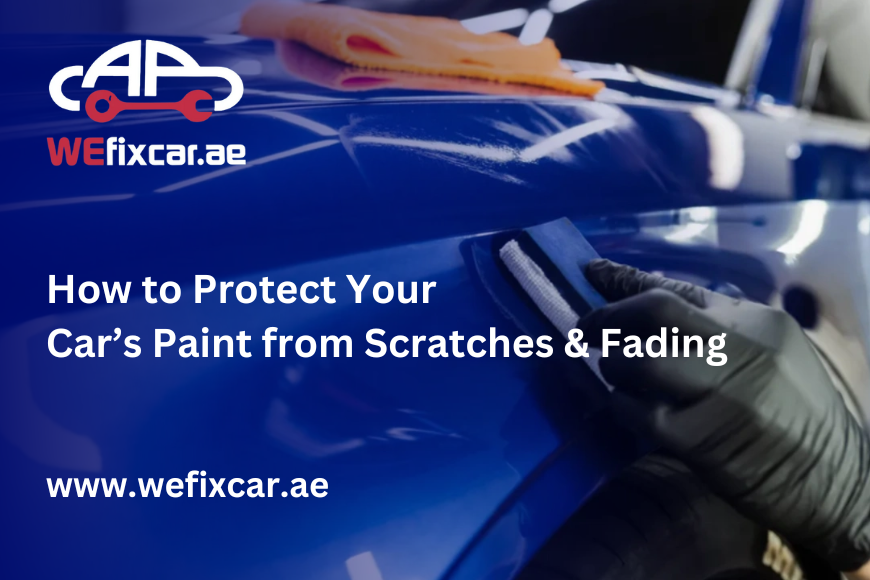The paint on your car is more than just a cosmetic feature—it plays a vital role in preserving the condition and value of your vehicle. Over time, however, the paint can suffer from various elements like UV damage, scratches, dirt, and even weather-related fading. This can result in a dull and damaged exterior, which is costly to repair.
Fortunately, there are several paint protection techniques and car maintenance tips that can help keep your car’s exterior looking like new. In this guide, we’ll discuss how to protect your car’s paint from scratches and fading, including the benefits of wax coatings, ceramic shields, and other essential care practices.
Why You Need to Protect Your Car’s Paint
Your car’s paint serves as its first line of defense against the environment. It shields the metal body from rust, corrosion, and damage caused by harmful elements. However, it is susceptible to a variety of factors that can lead to fading, discoloration, and scratches. Here are a few reasons why it’s important to protect your car’s paint:
- UV Damage: Constant exposure to sunlight can cause the paint to fade and lose its luster over time.
- Scratches and Swirl Marks: Regular washing, debris, or even accidental brushes with trees and bushes can cause small scratches on your paint.
- Environmental Pollutants: Pollutants like bird droppings, tree sap, and road salts can damage the surface and cause permanent stains if not cleaned off promptly.
- Water Spots: Hard water droplets can leave spots that are hard to remove, leading to dull patches in your paint job.
By taking the proper steps to protect your car’s paint, you can preserve its appearance and ensure that it lasts longer without needing costly refinishing.
1. Regularly Wash and Rinse Your Car
The first step in protecting your car’s paint is regular washing. Over time, dirt, grime, and other contaminants can accumulate on the surface of your vehicle. These pollutants can scratch or dull the paint if left for too long.
Best Practices for Washing Your Car
- Use the Two-Bucket Method: One bucket for soapy water and the other for rinsing your mitt or sponge. This prevents dirt from being reintroduced to the surface.
- Use a Microfiber Cloth: Microfiber is gentle on your car’s paint and effectively traps dirt without scratching.
- Rinse Thoroughly: Always rinse your car thoroughly before applying soap to ensure you’re not rubbing dirt into the paint.
- Dry Immediately: Use a clean microfiber towel to dry the car right after washing to prevent water spots from forming.
Frequent washing is an easy and effective way to protect the clear coat and prevent damage caused by dirt and grime.
2. Apply a Wax Coating
A wax coating is a great way to enhance the shine of your car’s paint while providing an added layer of protection. Wax creates a protective barrier between your car’s paint and the environment, making it more resistant to UV damage, water spots, and minor scratches.
Why Waxing Your Car Is Essential
- Protection Against UV Damage: Wax coatings offer a protective layer that shields the car’s paint from harmful UV rays. This helps prevent fading and keeps your car’s color vibrant for longer.
- Scratch Resistance: While wax won’t prevent all scratches, it does provide a thin layer that can absorb minor abrasions and protect the paint underneath.
- Water Beading: Waxed surfaces cause water to bead off the paint, preventing water spots and making it easier to clean your car.
How to Apply Car Wax
- Clean your car thoroughly before applying wax.
- Apply the wax in small sections using a foam applicator.
- Allow the wax to haze over, then buff it off using a clean microfiber towel.
Apply wax every 3 to 6 months for optimal protection and shine. You can also use spray wax for a quicker, though slightly less durable, option.
Ready to keep your car looking its best? Schedule a wax coating service with We Fix Car and protect your car’s paint from UV damage and fading!
3. Use a Ceramic Shield for Enhanced Protection
If you want the highest level of protection for your car’s paint, consider applying a ceramic shield. Ceramic coatings provide a long-lasting, hydrophobic layer that repels water, dirt, and other contaminants. Unlike wax, which needs to be reapplied regularly, a ceramic shield offers protection for up to 2-5 years.
Benefits of Ceramic Coatings
- Durability: A ceramic shield lasts much longer than traditional wax, meaning you won’t have to reapply it frequently.
- Superior UV Protection: It provides a stronger shield against UV rays, preventing the car’s paint from fading over time.
- Scratch Resistance: While not completely scratch-proof, ceramic coatings can significantly reduce the likelihood of scratches and swirl marks.
- Easier Cleaning: The hydrophobic properties of ceramic coatings make it much easier to clean your car as water and dirt slide off with minimal effort.
How to Apply a Ceramic Shield
Ceramic coatings are best applied by professionals to ensure an even, long-lasting finish. The process typically involves a thorough cleaning, decontamination, and application of the product to the surface.
Protect your car’s paint for the long haul! Ask about our ceramic shield application at We Fix Car for superior paint protection that lasts for years.
4. Regular Polishing and Buffing
Even with the best protection, your car’s paint can develop minor imperfections over time. Polishing and buffing can help restore the gloss and remove fine scratches, swirl marks, and oxidation that may have accumulated on the surface. Regular polishing also ensures that the protective layers, like wax or ceramic coating, adhere better to the surface.
How to Polish and Buff Your Car’s Paint
- Polishing: Use a soft pad and polishing compound to gently remove surface imperfections. This process can also enhance the paint’s depth and shine.
- Buffing: Buffing involves using a rotary buffer to remove a thin layer of the clear coat, improving the overall look of the paint.
Regular polishing is especially helpful if your car has been exposed to harsh elements or shows signs of oxidation.
5. Park in the Shade
Whenever possible, try to park your car in a shaded area, or better yet, in a garage. Prolonged exposure to direct sunlight can cause significant UV damage, leading to fading and deterioration of the paint. Parking in the shade, or using a car cover when outdoors, can drastically reduce the negative effects of sun exposure.
Frequently Asked Questions (FAQs)
1. How often should I wax my car?
It’s recommended to wax your car every 3 to 6 months, depending on the climate and exposure to environmental elements. This will help maintain a protective layer against UV damage and contaminants.
2. Can a ceramic coating replace wax?
Yes, a ceramic coating can provide longer-lasting protection compared to wax. However, waxing can still offer some benefits, such as enhanced shine and easier cleaning.
3. How can I prevent scratches on my car’s paint?
To avoid scratches, avoid brushing against trees, bushes, or debris while driving. When washing your car, use soft microfiber cloths and the two-bucket method to reduce the chance of scratching.
4. Can I apply a ceramic coating myself?
While it’s possible to apply a ceramic coating yourself, it’s recommended to seek professional help to ensure proper application and longevity.
5. Does waxing remove scratches?
Waxing can help hide minor scratches and swirl marks temporarily, but it doesn’t actually remove them. For deeper scratches, you may need to consider polishing or professional repair.
Conclusion
Maintaining the paint on your car is essential for preserving both its appearance and its long-term value. By regularly washing, waxing, applying a ceramic shield, and following basic protection tips, you can keep your car’s paint looking new for years to come.
If you’re ready to take the next step in protecting your car’s paint, consider scheduling a professional service at We Fix Car. Whether you need a wax coating or a ceramic shield application, we’re here to help you keep your car in pristine condition!
Book an appointment with us today and give your car the protection it deserves!



